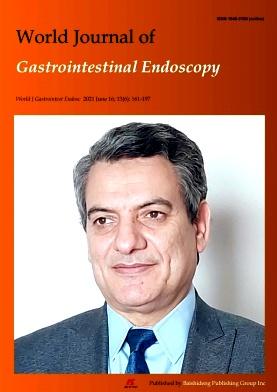Improved visibility of colorectal tumor by texture and color enhancement imaging with indigo carmine
IF 1.4
Q4 GASTROENTEROLOGY & HEPATOLOGY
引用次数: 0
Abstract
BACKGROUND Accurate diagnosis and early resection of colorectal polyps are important to prevent the occurrence of colorectal cancer. However, technical factors and morphological factors of polyps itself can lead to missed diagnoses. Image-enhanced endoscopy and chromoendoscopy (CE) have been developed to facilitate an accurate diagnosis. There have been no reports on visibility using a combination of texture and color enhancement imaging (TXI) and CE for colorectal tumors. AIM To investigate the visibility of margins and surfaces with the combination of TXI and CE for colorectal lesions. METHODS This retrospective study included patients who underwent lower gastrointestinal endoscopy at the Toyoshima Endoscopy Clinic. We extracted polyps that were resected and diagnosed as adenomas or serrated polyps (hyperplastic polyps and sessile serrated lesions) from our endoscopic database. An expert endoscopist performed the lower gastrointestinal endoscopies and observed the lesion using white light imaging (WLI), TXI, CE, and TXI + CE modalities. Indigo carmine dye was used for CE. Three expert endoscopists rated the visibility of the margin and surface patterns in four ranks, from 1 to 4. The primary outcomes were the average visibility scores for the margin and surface patterns based on the WLI, TXI, CE, and TXI + CE observations. Visibility scores between the four modalities were compared by the Kruskal-Wallis and Dunn tests. RESULTS A total of 48 patients with 81 polyps were assessed. The histological subtypes included 50 tubular adenomas, 16 hyperplastic polyps, and 15 sessile serrated lesions. The visibility scores for the margins based on WLI, TXI, CE, and TXI + CE were 2.44 ± 0.93, 2.90 ± 0.93, 3.37 ± 0.74, and 3.75 ± 0.49, respectively. The visibility scores for the surface based on WLI, TXI, CE, and TXI + CE were 2.25 ± 0.80, 2.84 ± 0.84, 3.12 ± 0.72, and 3.51 ± 0.60, respectively. The visibility scores for the detection and surface on TXI were significantly lower than that on CE but higher than that on WLI (P < 0.001). The visibility scores for the margin and surface on TXI + CE were significantly higher than those on CE (P < 0.001). In the sub-analysis of adenomas, the visibility for the margin and surface on TXI + CE was significantly better than that on WLI, TXI, and CE (P < 0.001). In the sub-analysis of serrated polyps, the visibility for the margin and surface on TXI + CE was also significantly better than that on WLI, TXI, and CE (P < 0.001). CONCLUSION TXI + CE enhanced the visibility of the margin and surface compared to WLI, TXI, and CE for colorectal lesions.用靛蓝胭脂红进行纹理和色彩增强成像,提高结直肠肿瘤的可见度
背景准确诊断和早期切除大肠息肉对预防大肠癌的发生非常重要。然而,技术因素和息肉本身的形态因素可能导致漏诊。图像增强内镜和色素内镜(CE)的发展有助于准确诊断。目前还没有关于结合纹理和颜色增强成像(TXI)和 CE 对结直肠肿瘤进行能见度检查的报道。目的 研究结合 TXI 和 CE 检查结直肠病变时边缘和表面的可见度。方法 这项回顾性研究包括在丰岛内窥镜诊所接受下消化道内窥镜检查的患者。我们从内镜数据库中提取了切除并诊断为腺瘤或锯齿状息肉(增生性息肉和无柄锯齿状病变)的息肉。由一名内镜专家进行下消化道内镜检查,并使用白光成像(WLI)、TXI、CE 和 TXI + CE 模式观察病变。CE 使用靛胭脂红染料。三位内镜专家将边缘和表面形态的可见度分为四级,从1到4。 主要结果是基于WLI、TXI、CE和TXI + CE观察的边缘和表面形态的平均可见度得分。通过 Kruskal-Wallis 和 Dunn 检验对四种模式的可见度评分进行比较。结果 共对 48 名患者的 81 个息肉进行了评估。组织学亚型包括 50 个管状腺瘤、16 个增生性息肉和 15 个无柄锯齿状病变。基于 WLI、TXI、CE 和 TXI + CE 的边缘可见度评分分别为 2.44 ± 0.93、2.90 ± 0.93、3.37 ± 0.74 和 3.75 ± 0.49。基于 WLI、TXI、CE 和 TXI + CE 的表面能见度得分分别为 2.25 ± 0.80、2.84 ± 0.84、3.12 ± 0.72 和 3.51 ± 0.60。TXI 的检测和表面能见度得分明显低于 CE,但高于 WLI(P < 0.001)。TXI+CE的边缘和表面可见度得分明显高于CE(P < 0.001)。在腺瘤子分析中,TXI + CE 的边缘和表面能见度明显优于 WLI、TXI 和 CE(P < 0.001)。在锯齿状息肉的子分析中,TXI + CE 的边缘和表面能见度也明显优于 WLI、TXI 和 CE(P < 0.001)。结论 与 WLI、TXI 和 CE 相比,TXI + CE 提高了结直肠病变边缘和表面的可见度。
本文章由计算机程序翻译,如有差异,请以英文原文为准。
求助全文
约1分钟内获得全文
求助全文

 求助内容:
求助内容: 应助结果提醒方式:
应助结果提醒方式:


